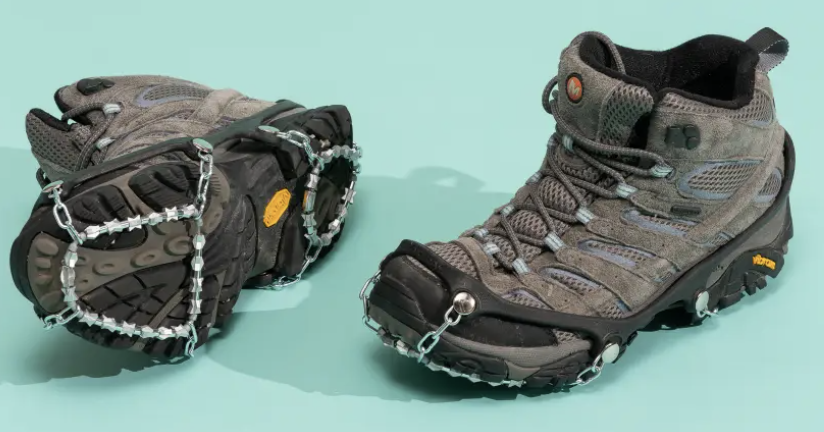Traction on Ice and Snow: Stay Safe in Winter Conditions
Walking or hiking on ice and snow can be slippery, unpredictable, and hazardous. Whether you're navigating city sidewalks, trekking through backcountry trails, or working in icy conditions, having proper footwear and traction aids can significantly improve your stability, grip, and confidence on slippery surfaces.

Essential Winter Walking Tips
Choose the Right Footwear
Winter Boots with Deep Tread – Look for rubber soles with aggressive lugs (such as Vibram® soles) designed for icy and snowy terrain.
Waterproof & Insulated – Keep your feet warm and dry with materials like GORE-TEX or waterproof leather.
Ankle Support – Boots with a secure fit and ankle support reduce the risk of slipping or twisting your foot.
Pro Tip: You can waterproof leather boots using Sno-Seal® or another wax-based product.
Use Ice Cleats, Crampons & Traction Devices
Ice cleats and traction aids attach to your boots to provide extra grip on ice and packed snow. Different styles are suited for urban walking, hiking, or extreme conditions.
Best Ice Cleats & Traction Devices
Kahtoola MICROspikes – Heavy-duty stainless steel spikes for hiking, mountaineering & backcountry trails.

Yaktrax Pro Traction Cleats – Lightweight, affordable steel coil design for everyday walking.

STABILicers Maxx Original – Durable steel cleats for harsh winter environments.

Hillsound Trail Crampons – Stainless steel spikes for hikers & trail runners.

Due North Everyday G3 – Slip-on steel cleats for daily winter commuting.

ICEtrekkers Diamond Grip – Multi-directional steel grips for urban & outdoor use.

Pro Tip: If hiking in steep or mountainous terrain, consider crampons with longer spikes for added security.
Walk Like a Penguin
Take small, shuffling steps instead of long strides.
Keep your center of gravity low by bending your knees slightly.
Place your whole foot down at once (not just your heel or toes).
Point your toes slightly outward for better balance.
Keep your hands out of your pockets to help maintain balance.
Pro Tip: If you must carry something, use a backpack to keep your hands free for balance.
Use Trekking Poles or a Walking Stick
Trekking poles provide added stability on slippery slopes and uneven terrain. Look for:
Poles with carbide or steel tips for grip on icy surfaces.
Adjustable-length poles to adapt to varied terrain.
Wrist straps for extra control and ease of use.
Pro Tip: If using a cane, add an ice grip attachment to the tip for better traction.

Stay on Cleared & Treated Paths
Walk on plowed sidewalks, salted paths, or sanded trails when possible.
Avoid untreated surfaces or thin ice on bodies of water.
Carry a small bag of sand or salt to sprinkle on dangerous spots.
Pro Tip: Black ice is hard to see—test surfaces before stepping forward!
Plan Ahead & Adjust Your Pace
Slow down – Rushing increases the risk of slipping.
Allow extra time – Winter conditions demand caution.
Check the weather – If conditions are severe, consider delaying travel or using alternative transportation.
Pro Tip: Avoid carrying heavy loads that throw off your balance—use a backpack instead.
Carry an Emergency Kit (For Remote or Extended Outdoor Travel)
Flashlight or headlamp – In case of reduced visibility.
Extra clothing & gloves – For warmth in case of a delay.
High-energy snacks – To keep energy levels up.
First aid kit – In case of minor injuries.
Whistle – For signaling if stranded.
Pro Tip: If venturing off-grid, carry a GPS device or satellite communicator for emergency contact.
Driving on Icy Roads: Black Ice Awareness
Black ice is a thin, transparent layer of ice that’s almost invisible on roads.
How to Spot Black Ice:
Roads that look extra glossy, wet, or unusually smooth.
Bridges, overpasses, and shaded areas freeze first.
A Sudden lack of tire noise on the pavement (indicates ice).
How to Drive on Ice:
Slow down – Reduce speed by at least 30-50%.
Brake gently – Avoid sudden braking or acceleration.
Steer smoothly – Avoid sharp turns or jerky movements.
Increase following distance – Keep 8-10 seconds behind other vehicles.
Use low gears – Especially when driving downhill.
Pro Tip: If you start sliding, turn into the skid to regain control—don’t slam the brakes!

Be Winter-Ready!
Winter doesn’t have to slow you down—with the right gear and precautions, you can safely navigate icy sidewalks, trails, and roads.
Gear Up → Invest in traction devices, proper boots & trekking poles.
Move Smart → Take small, careful steps & adjust your walking technique.
Be Prepared → Check weather forecasts, stay on cleared paths & carry essentials.